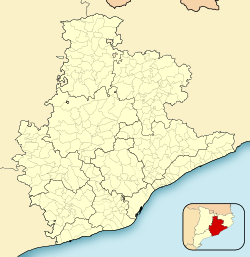Sagàs
Sagàs | |
|---|---|
 Church of Sant Andreu. | |
 Location in Berguedà | |
| Coordinates: 42°02′17″N 1°58′19″E / 42.038°N 1.972°E | |
| Country | |
| Community | |
| Province | Barcelona |
| Comarca | Berguedà |
| Government | |
| • Mayor | Silvia Triola Costa (2015)[1] (AES) |
| Area | |
| • Total | 44.6 km2 (17.2 sq mi) |
| Elevation | 738 m (2,421 ft) |
| Population (2018)[3] | |
| • Total | 161 |
| • Density | 3.6/km2 (9.3/sq mi) |
| Demonym | Saganès |
| Website | www |
Sagàs is a small town and municipality located in Catalonia, in the comarca of Berguedà. It is located in the geographical area of the pre-Pyrenees.
Population
Sagàs is essentially a collection of farmhouses, or masies, separated by low wooded ridges and cultivated fields. The municipality is made up of five separate villages (Sant Andreu de Sagàs, El Carrer de Bonaire, Biure de Berguedà, La Guàrdia de Sagàs, and Valloriola) and two parishes (Sant Andreu de Sagàs and Santa Maria de la Guàrdia). Traditionally, the people of Sagàs made their living from agriculture. While this is still true for most of the inhabitants of Sagàs, the increased mechanization of farming has led to a growth in rural tourism, as well as a drop in population—the town has a growth rate of negative 10.4 percent.[4]
Coat of arms
Although Sagàs has no coat of arms officially recognized by the
Celebrations
The festa major or "town festival" is held on November 30, the
Main sights
- Church of Sant Andreu (Saint Andrew). This structure has origins in a church dedicated to Saint Andrew from the 11th century. The current church was built in the Romanesque style. It has a typical basilican floor-plan, with three naves, each crowned separately by a semi-circular apse. The church was heavily modified in the 15th century, with major interior changes as well as the addition of the present bell-tower. The altar is also famous. Beginning in 1970, a number of locals started a movement to restore the church to its original 11th-century appearance. It stands today restored.[6]
- Church of Sant Esteve de Valldoriola
- Chapel of Santa Margarida de Sagàs, built in the 10th century or earlier.[6]
- Chapel of Sant Jordi, a small chapel dedicated to Saint George
- Church of Sant Martí de Biure, a 10th-century Romanesque church.[6]
- Church of Santa Maria de la Guàrdia, and its famous statue of the Virgin Mary. Located on a hill over the Llobregat valley, it is a well known for its vistas.
- Ruins of the Tower of Sagàs, a small fortress from the 5th century.[6]
History
Before the arrival of the
In Medieval times, the first written reference to Sagàs appears in a document from 903, describing the consecration of the Church of Sant Andreu by the
Though Sagàs originally was part of the
It seems Sagàs has always been a farming town, with little strategic importance, although a small castle (about three metres by six metres at the base) was built there between the tenth and twelfth centuries.[6]
In 1994, Sagàs was ravaged by wildfires that burnt much of the comarques of Berguedà and Bages;[12] much of the forest that once characterized the town was lost, and the town's farms were dealt a serious blow.
References
- Generalitat of Catalonia. Retrieved 2015-11-13.
- Statistical Institute of Catalonia. Retrieved 2015-11-23.
- ^ Municipal Register of Spain 2018. National Statistics Institute.
- ^ Idescat. Fitxes municipals
- ^ "Ajuntament de Sagās". Archived from the original on 2012-02-05. Retrieved 2012-02-17.
- ^ a b c d e f Catalunya Romànica. Vol. XII El Berguedà. Enciclopèdia Catalana. Barcelona, 1985
- ^ a b "Ajuntament de Sagās". Archived from the original on 2012-02-05. Retrieved 2012-02-17.
- ^ a b The Project Gutenberg EBook of History of Rome, Vol III, by Titus Livius https://www.gutenberg.org/files/12582/12582-h/12582-h.htm#h17
- ^ Livius, T. "Ab Urbe condita Libri" (in Latin). The Latin Library. Retrieved 17 February 2011. http://www.thelatinlibrary.com/livy/liv.34.shtml#17
- ^ Montenegro Duque, Ángel. España Romana. Madrid: Editorial Gredos, 1986. P. 47
- ^ Coromines, Joan. Onomasticon Cataloniae. Vol VI, p.45, s.v. Olvan.
- ^ "El procés judicial pels incendis del Bages i el Berguedà de fa deu anys encara no s'ha resolt". 4 July 2004.
External links
- Official website (in Catalan)
- Government data pages (in Catalan)




